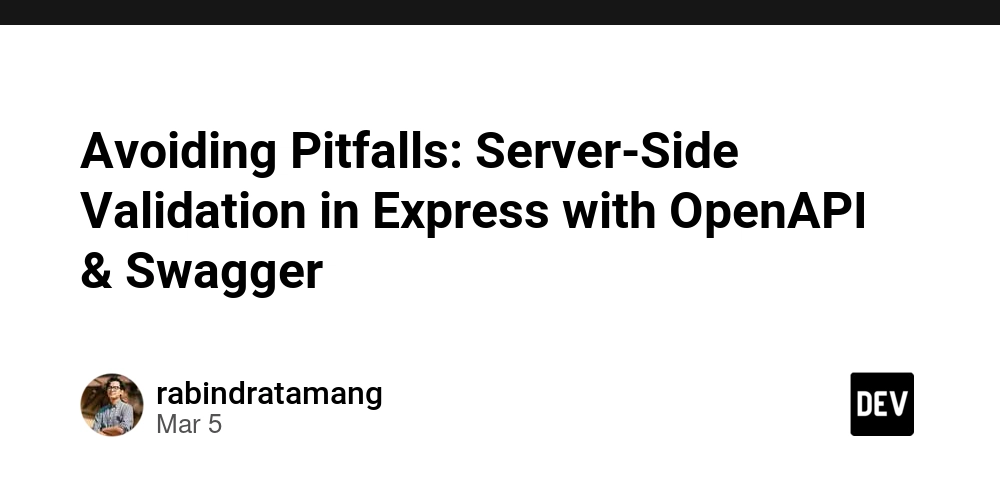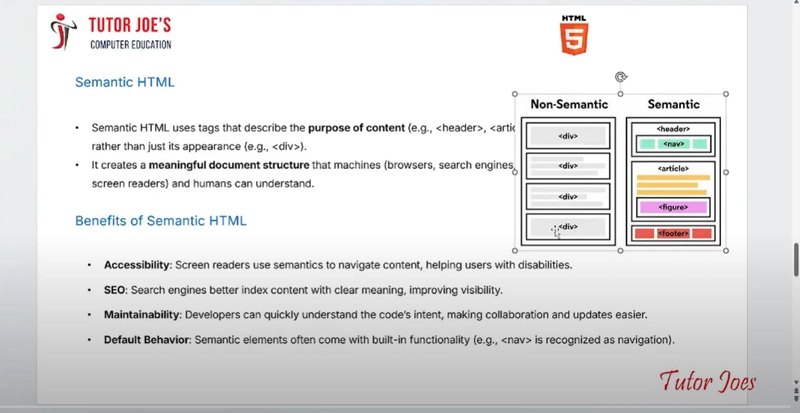Avoiding Pitfalls: Server-Side Validation in Express with OpenAPI & Swagger
Why Server-Side Validation Is Non-Negotiable While frontend validation improves user experience by catching errors early, it should never be the sole layer of protection. Relying only on frontend validation is a major security flaw because: APIs are meant to be consumed by various clients, including third-party applications. Attackers can bypass the UI and send malicious data directly to the API. Data integrity issues can arise due to incomplete or incorrect input. Solution: Implement robust server-side validation. Industry Standards for Server-Side Validation in Express 1. Use a Validation Library Manually writing validation logic for each request is tedious and error-prone. Instead, use libraries like: Joi (powerful schema-based validation) Express-validator (based on validator.js, integrates well with Express) Yup (often used with TypeScript, works with objects) Example using Joi const Joi = require('joi'); const userSchema = Joi.object({ name: Joi.string().min(3).max(30).required(), email: Joi.string().email().required(), age: Joi.number().integer().min(18).max(99).required(), }); const validateUser = (req, res, next) => { const { error } = userSchema.validate(req.body); if (error) return res.status(400).json({ error: error.details[0].message }); next(); }; app.post('/users', validateUser, (req, res) => { res.json({ message: 'User created successfully!' }); }); Example using express-validator Example: Validating a User Registration Endpoint const { body, validationResult } = require('express-validator'); app.post('/api/register', [ // Validate email body('email') .isEmail() .withMessage('Please provide a valid email address.') .normalizeEmail(), // Sanitize: normalize the email format // Validate password body('password') .isLength({ min: 8 }) .withMessage('Password must be at least 8 characters long.') .matches(/[A-Z]/) .withMessage('Password must contain at least one uppercase letter.') .matches(/[0-9]/) .withMessage('Password must contain at least one number.'), // Validate username body('username') .trim() // Sanitize: remove whitespace .isLength({ min: 3, max: 20 }) .withMessage('Username must be between 3 and 20 characters long.') .matches(/^[a-zA-Z0-9_]+$/) .withMessage('Username can only contain letters, numbers, and underscores.'), ], (req, res) => { // Check for validation errors const errors = validationResult(req); if (!errors.isEmpty()) { return res.status(400).json({ errors: errors.array() }); } // If validation passes, proceed with business logic const { email, password, username } = req.body; // Save user to the database, etc. res.status(201).json({ message: 'User registered successfully!' }); }); 2. Enforce OpenAPI Schema Validation Since we use OpenAPI (Swagger) for API documentation, we also leverage it for validation. Tools like express-openapi-validator help enforce schema-based validation from our OpenAPI definitions. Install it: npm install express-openapi-validator Use it in Express: const { OpenApiValidator } = require('express-openapi-validator'); const swaggerUi = require('swagger-ui-express'); const YAML = require('yamljs'); const swaggerDocument = YAML.load('./swagger.yaml'); app.use('/api-docs', swaggerUi.serve, swaggerUi.setup(swaggerDocument)); app.use( OpenApiValidator.middleware({ apiSpec: './swagger.yaml', validateRequests: true, // Validate request bodies, parameters, and headers validateResponses: true, // Validate responses (optional) }) ); This ensures that API requests adhere to our OpenAPI specification, reducing inconsistencies and vulnerabilities. 3. Implement Middleware for Reusable Validation Middleware allows reusing validation logic across multiple routes. For instance, a middleware function can validate user authentication or check request headers before processing data. Example: const validateApiKey = (req, res, next) => { if (!req.headers['x-api-key']) { return res.status(403).json({ error: 'API key is required' }); } next(); }; app.use(validateApiKey); 4. Secure Input Data with Sanitization Validation should go hand-in-hand with sanitization to prevent SQL injection, XSS, or unwanted input. Example using express-validator: const { body } = require('express-validator'); app.post( '/comment', [ body('text').trim().escape().notEmpty().withMessage('Comment cannot be empty'), ], (req, res) => { // Process comment res.json({ message: 'Comment added' }); } ); 5. Log Validation Failures for Debugging When validation fails, logging helps diagnose issues. Use a logging library like winston or pino. const winston = require('winston'); const logger = winston.createLogger({ transports: [new winston.transports.Console()],

Why Server-Side Validation Is Non-Negotiable
While frontend validation improves user experience by catching errors early, it should never be the sole layer of protection. Relying only on frontend validation is a major security flaw because:
- APIs are meant to be consumed by various clients, including third-party applications.
- Attackers can bypass the UI and send malicious data directly to the API.
- Data integrity issues can arise due to incomplete or incorrect input.
Solution: Implement robust server-side validation.
Industry Standards for Server-Side Validation in Express
1. Use a Validation Library
Manually writing validation logic for each request is tedious and error-prone. Instead, use libraries like:
- Joi (powerful schema-based validation)
- Express-validator (based on validator.js, integrates well with Express)
- Yup (often used with TypeScript, works with objects)
Example using Joi
const Joi = require('joi');
const userSchema = Joi.object({
name: Joi.string().min(3).max(30).required(),
email: Joi.string().email().required(),
age: Joi.number().integer().min(18).max(99).required(),
});
const validateUser = (req, res, next) => {
const { error } = userSchema.validate(req.body);
if (error) return res.status(400).json({ error: error.details[0].message });
next();
};
app.post('/users', validateUser, (req, res) => {
res.json({ message: 'User created successfully!' });
});
Example using express-validator
Example: Validating a User Registration Endpoint
const { body, validationResult } = require('express-validator');
app.post('/api/register', [
// Validate email
body('email')
.isEmail()
.withMessage('Please provide a valid email address.')
.normalizeEmail(), // Sanitize: normalize the email format
// Validate password
body('password')
.isLength({ min: 8 })
.withMessage('Password must be at least 8 characters long.')
.matches(/[A-Z]/)
.withMessage('Password must contain at least one uppercase letter.')
.matches(/[0-9]/)
.withMessage('Password must contain at least one number.'),
// Validate username
body('username')
.trim() // Sanitize: remove whitespace
.isLength({ min: 3, max: 20 })
.withMessage('Username must be between 3 and 20 characters long.')
.matches(/^[a-zA-Z0-9_]+$/)
.withMessage('Username can only contain letters, numbers, and underscores.'),
], (req, res) => {
// Check for validation errors
const errors = validationResult(req);
if (!errors.isEmpty()) {
return res.status(400).json({ errors: errors.array() });
}
// If validation passes, proceed with business logic
const { email, password, username } = req.body;
// Save user to the database, etc.
res.status(201).json({ message: 'User registered successfully!' });
});
2. Enforce OpenAPI Schema Validation
Since we use OpenAPI (Swagger) for API documentation, we also leverage it for validation. Tools like express-openapi-validator help enforce schema-based validation from our OpenAPI definitions.
Install it:
npm install express-openapi-validator
Use it in Express:
const { OpenApiValidator } = require('express-openapi-validator');
const swaggerUi = require('swagger-ui-express');
const YAML = require('yamljs');
const swaggerDocument = YAML.load('./swagger.yaml');
app.use('/api-docs', swaggerUi.serve, swaggerUi.setup(swaggerDocument));
app.use(
OpenApiValidator.middleware({
apiSpec: './swagger.yaml',
validateRequests: true, // Validate request bodies, parameters, and headers
validateResponses: true, // Validate responses (optional)
})
);
This ensures that API requests adhere to our OpenAPI specification, reducing inconsistencies and vulnerabilities.
3. Implement Middleware for Reusable Validation
Middleware allows reusing validation logic across multiple routes. For instance, a middleware function can validate user authentication or check request headers before processing data.
Example:
const validateApiKey = (req, res, next) => {
if (!req.headers['x-api-key']) {
return res.status(403).json({ error: 'API key is required' });
}
next();
};
app.use(validateApiKey);
4. Secure Input Data with Sanitization
Validation should go hand-in-hand with sanitization to prevent SQL injection, XSS, or unwanted input.
Example using express-validator:
const { body } = require('express-validator');
app.post(
'/comment',
[
body('text').trim().escape().notEmpty().withMessage('Comment cannot be empty'),
],
(req, res) => {
// Process comment
res.json({ message: 'Comment added' });
}
);
5. Log Validation Failures for Debugging
When validation fails, logging helps diagnose issues. Use a logging library like winston or pino.
const winston = require('winston');
const logger = winston.createLogger({
transports: [new winston.transports.Console()],
});
const validateRequest = (schema) => (req, res, next) => {
const { error } = schema.validate(req.body);
if (error) {
logger.error(`Validation Error: ${error.details[0].message}`);
return res.status(400).json({ error: error.details[0].message });
}
next();
};
Final Thoughts
Our experience taught us a valuable lesson: server-side validation is not optional. By integrating validation at the API level, we:
- Prevent malicious input
- Ensure data integrity
- Improve API security
- Maintain consistency across clients
- Write automated tests to validate your validation logic.
If you're building APIs with Express and OpenAPI, make sure to enforce validation from day one to avoid last-minute surprises.











































































































































































![[The AI Show Episode 142]: ChatGPT’s New Image Generator, Studio Ghibli Craze and Backlash, Gemini 2.5, OpenAI Academy, 4o Updates, Vibe Marketing & xAI Acquires X](https://www.marketingaiinstitute.com/hubfs/ep%20142%20cover.png)




























































































































![[DEALS] The Premium Learn to Code Certification Bundle (97% off) & Other Deals Up To 98% Off – Offers End Soon!](https://www.javacodegeeks.com/wp-content/uploads/2012/12/jcg-logo.jpg)


![From drop-out to software architect with Jason Lengstorf [Podcast #167]](https://cdn.hashnode.com/res/hashnode/image/upload/v1743796461357/f3d19cd7-e6f5-4d7c-8bfc-eb974bc8da68.png?#)








































































































.png?#)

































_Christophe_Coat_Alamy.jpg?#)
 (1).webp?#)





































































































![Apple Considers Delaying Smart Home Hub Until 2026 [Gurman]](https://www.iclarified.com/images/news/96946/96946/96946-640.jpg)
![iPhone 17 Pro Won't Feature Two-Toned Back [Gurman]](https://www.iclarified.com/images/news/96944/96944/96944-640.jpg)
![Tariffs Threaten Apple's $999 iPhone Price Point in the U.S. [Gurman]](https://www.iclarified.com/images/news/96943/96943/96943-640.jpg)




































































































































